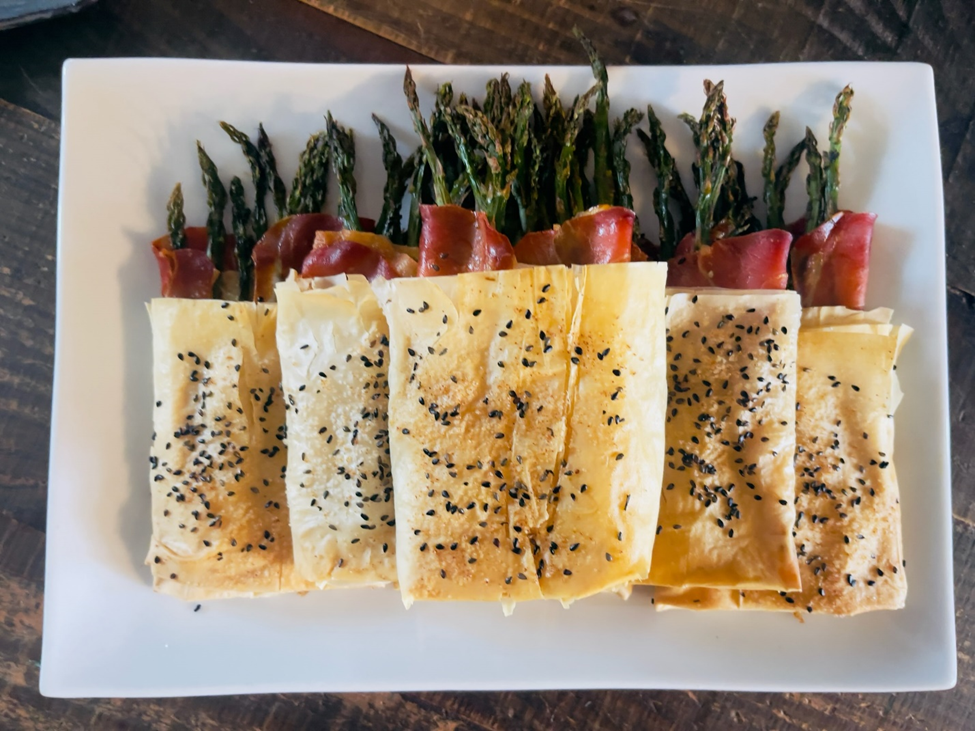Asparagus Easter Baskets

If you’re like most folks, when you think Easter, you immediately think of eggs. Eggs are a universal symbol of Easter, representing new life and rebirth. Hard-boiled eggs are often dyed or decorated and used for Easter egg hunts or table decorations. While this activity is usually reserved for kids, I know I still enjoy this tradition and look forward to it every year. (I can’t be the only one!)
While there are many ways you can prepare eggs (my favorite being deviled), there are other foods that are synonymous with Easter that may not be as universal.
Traditional Easter foods vary widely depending on cultural and regional customs. Here are some examples of Easter foods from different parts of the world:
Roasted Lamb: Lamb is a common Easter dish in many cultures, symbolizing sacrifice and renewal. It is often served as the main course for Easter dinner.
Easter Ham: In some Western countries, particularly in the United States, ham is a popular Easter dish. It is often glazed with a sweet sauce and served with side dishes like mashed potatoes and vegetables.
Easter Bread: Various types of sweet bread, often enriched with eggs and flavored with spices or citrus zest, are traditional Easter treats in many European countries. Examples include Italian panettone, Greek tsoureki, and Polish babka.
Hot Cross Buns: These spiced, sweet buns, marked with a cross on top, are traditionally eaten on Good Friday in several countries, including the United Kingdom, Ireland, Australia, and New Zealand.
Pascha (Paskha): Pascha is a traditional Russian Easter dessert made from farmer’s cheese (tvorog), eggs, sugar, butter, and dried fruits. It is often shaped into a pyramid or dome and decorated with religious symbols.
Colomba di Pasqua: This Italian Easter cake is similar to panettone but shaped like a dove (Colomba in Italian), symbolizing peace and resurrection.
Folar: Folar is a Portuguese Easter bread typically made with eggs, sugar, and flour. It may be plain or filled with meats or other ingredients.
Lamb Cake: In some regions, especially in Eastern Europe and parts of the United States, lamb-shaped or molded cakes are popular Easter desserts, often made of pound or sponge cake.
Koulourakia: These Greek Easter cookies are traditionally shaped into twists or braids and flavored with orange zest and vanilla. They are often served with coffee or tea during Easter celebrations.
These are just a few examples of traditional Easter foods enjoyed around the world. The specific dishes and customs vary greatly from one region to another, but they all reflect the significance of Easter as a time of celebration, renewal, and fellowship.
I decided rather than make a traditional Easter dish to include in my menu this year, I would go with something that was spring-like and incorporate one of my favorite new veggies—asparagus.
While this can be a love-it-or-hate-it type of food for many folks, asparagus is a nutrient-rich vegetable that offers several health benefits. Here are some of the key health benefits associated with asparagus:
Nutrient-Dense: Asparagus is low in calories and rich in essential nutrients, including vitamins A, C, E, and K, as well as folate, potassium, and fiber.
Antioxidant Properties: Asparagus contains various antioxidants, such as vitamin C, beta-carotene, and flavonoids, which help neutralize harmful free radicals in the body and reduce oxidative stress, thus lowering the risk of chronic diseases like cancer and heart disease.
Anti-Inflammatory Effects: Asparagus contains certain compounds, including saponins and flavonoids, with anti-inflammatory properties. Consuming asparagus may help the body balance inflammation levels.
Digestive Health: Asparagus is a good source of dietary fiber, which promotes healthy digestion by adding bulk to stool and preventing constipation. Fiber also supports the growth of beneficial gut bacteria, contributing to overall digestive health.
Heart Health: Asparagus is low in sodium and high in potassium, which helps regulate blood pressure and reduce the risk of hypertension and cardiovascular disease. Additionally, its folate content may help lower levels of homocysteine, an amino acid associated with an increased risk of heart disease.
Blood Sugar Control: Asparagus has a low glycemic index and contains soluble fiber, which slows down the absorption of sugar into the bloodstream. This may help stabilize blood sugar levels and reduce the risk of type 2 diabetes.
Weight Management: Asparagus is low in calories and high in fiber, making it a filling and satisfying addition to meals. Its fiber content also aids digestion and promotes a feeling of fullness, which may help with weight management by reducing overall calorie intake.
Bone Health: Asparagus is a good source of vitamin K, which plays a crucial role in bone health by aiding in calcium absorption and promoting bone mineralization. Consuming adequate amounts of vitamin K may help reduce the risk of osteoporosis and fractures.
I hope you enjoy what I came up with: Asparagus Easter Baskets! Let me know if you give it a try.
Ingredients
- 2 bunches fresh asparagus about 27 stalks
- 1 package puff pastry
- 2 ounces prosciutto sliced (about 9 slices)
- Provolone or Parmesan cheese or your favorite cheese
- 1 egg beaten
- Everything but the Bagel Seasoning or sesame seeds
Instructions
- Preheat oven to 375° F.
- Rinse the asparagus and cut (or preferably snap) about 2 – 3 inches off of the bottom of the asparagus.
- Cut one sheet of puff pastry into nine squares.
- Fold in prosciutto, cheese, and asparagus and seal tightly (like a little basket).
- Brush with the beaten egg and sprinkle everything but the bagel seasoning or sesame seeds on top.
- Place on a parchment-lined baking sheet.
- Bake in the oven for 20 – 25 minutes, until puff pastry is golden brown and cheese is melted.
- Enjoy!




